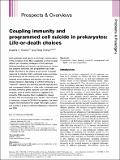| dc.contributor.author | Koonin, Eugene V. | |
| dc.contributor.author | Zhang, Feng | |
| dc.date.accessioned | 2017-12-12T16:46:11Z | |
| dc.date.available | 2017-12-12T16:46:11Z | |
| dc.date.issued | 2016-12 | |
| dc.identifier.issn | 0265-9247 | |
| dc.identifier.issn | 1521-1878 | |
| dc.identifier.uri | http://hdl.handle.net/1721.1/112717 | |
| dc.description.abstract | Host-pathogen arms race is a universal, central aspect of the evolution of life. Most organisms evolved several distinct yet interacting strategies of anti-pathogen defense including resistance to parasite invasion, innate and adaptive immunity, and programmed cell death (PCD). The PCD is the means of last resort, a suicidal response to infection that is activated when resistance and immunity fail. An infected cell faces a decision between active defense and altruistic suicide or dormancy induction, depending on whether immunity is “deemed” capable of preventing parasite reproduction and consequent infection of other cells. In bacteria and archaea, immunity genes typically colocalize with PCD modules, such as toxins-antitoxins, suggestive of immunity-PCD coupling, likely mediated by shared proteins that sense damage and “predict” the outcome of infections. In type VI CRISPR-Cas systems, the same enzyme that inactivates the target RNA might execute cell suicide, in a case of ultimate integration of immunity and PCD. | en_US |
| dc.publisher | Wiley Blackwell | en_US |
| dc.relation.isversionof | http://dx.doi.org/10.1002/bies.201600186 | en_US |
| dc.rights | Creative Commons Attribution-NonCommercial-NoDerivs License | en_US |
| dc.rights.uri | http://creativecommons.org/licenses/by-nc-nd/4.0/ | en_US |
| dc.source | Wiley | en_US |
| dc.title | Coupling immunity and programmed cell suicide in prokaryotes: Life-or-death choices | en_US |
| dc.type | Article | en_US |
| dc.identifier.citation | Koonin, Eugene V., and Zhang, Feng . “Coupling Immunity and Programmed Cell Suicide in Prokaryotes: Life-or-Death Choices.” BioEssays 39, 1 (November 2016): e201600186 © 2016 The Authors | en_US |
| dc.contributor.department | Harvard University--MIT Division of Health Sciences and Technology | en_US |
| dc.contributor.department | Massachusetts Institute of Technology. Department of Brain and Cognitive Sciences | en_US |
| dc.contributor.department | McGovern Institute for Brain Research at MIT | en_US |
| dc.contributor.mitauthor | Zhang, Feng | |
| dc.relation.journal | BioEssays | en_US |
| dc.eprint.version | Final published version | en_US |
| dc.type.uri | http://purl.org/eprint/type/JournalArticle | en_US |
| eprint.status | http://purl.org/eprint/status/PeerReviewed | en_US |
| dc.date.updated | 2017-12-12T16:31:12Z | |
| dspace.orderedauthors | Koonin, Eugene V.; Zhang, Feng | en_US |
| dspace.embargo.terms | N | en_US |
| dc.identifier.orcid | https://orcid.org/0000-0003-2782-2509 | |
| mit.license | PUBLISHER_CC | en_US |
| mit.metadata.status | Complete | |
